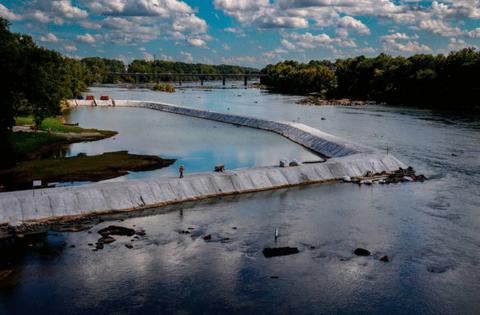Toxin was released into the Congaree River in South Carolina. But agencies did little to stop it, greens say
Published in News & Features
COLUMBIA, S.C. — High amounts of a toxic chemical are being discharged into the Congaree and Cooper rivers from plastics factories in South Carolina, but state and federal regulators are doing little to control the pollution, a new report says.
A study by the Environmental Integrity Project, a national public interest organization, found that of eight similar plastics plants it studied, factories near Columbia and Charleston had some of the highest releases of 1,4- dioxane, a chemical tied to an array of health ailments, including cancer.
An Alpek Polyester plant in the Gaston area near Columbia released 23,728 pounds of 1,4-dioxane to the Congaree River in 2022, ranking it second in total releases behind only a plant in West Virginia that discharged 29,960 pounds. Alpek’s plant at Moncks Corner near Charleston released 9,756 pounds to the Cooper River, the report said.
But according to the report, there are no federal limits on how much 1,4-dioxane can be released from plastics plants. West Virginia only recently added state discharge limits for the plant in that state, the study said.
“This toxic pollution from plastic production is unacceptable,’’ Congaree Riverkeeper Bill Stangler said in a statement released by the Environmental Integrity Project. “Our federal and state agencies need to step up and protect our river and the downstream communities.’’
Efforts to reach someone who could speak for Alpek were unsuccessful. The company, formerly known as DAK Americas, is part a corporation that employs nearly, 4,000 people worldwide. At one time, the plant in the Gaston area had about 400 workers.
The S.C. Department of Environmental Services did not respond to questions Thursday from The State, saying it could not discuss the 1,4-dioxane issue until a later date.
Stangler said the releases in the Columbia area are near Congaree National Park, a preserve filled with wildlife and the state’s only national park. The Alpek discharges to the Congaree River are below drinking water intakes in Columbia, West Columbia and Cayce, but Stangler said they are upstream from several drinking water pipes in the Santee Cooper lakes area southeast of Columbia.
The Environmental Integrity Project report, released Thursday, took a broader look at various discharges in wastewater released from 70 petrochemical and plastic plants that produce plastics across the country. The group focused on plastics because the industry is growing across the country. The plants were those that produced plastic materials for other plastic products.
Most of the plants studied in the United States have few, if any, government limits on the amount of nitrogen, phosphoros, 1,4-dioxane, dioxins and other harmful pollutants discharged to rivers, the report said. The group’s study included data from the federal Toxics Release Inventory, an annual report that lists what the U.S. government considers legal pollution discharges.
The Centers for Disease Control and Prevention says exposure to high levels of 1,4 dioxane can result in liver and kidney damage. Although the EPA was criticized for not doing enough to control discharges to rivers from plastics plants, the agency has said 1,4 dioxane is a probable human carcinogen.
In addition to concerns about 1,4-dioxane in South Carolina, the report questioned the environmental impacts of “nurdles,’’ tiny pellets used to manufacture other plastic materials. It said discharges of these materials into waterways are common. In 2021, a pellet packaging and shipping company settled a lawsuit for $1.2 million over nurdle releases to Charleston Harbor.
Environmental Integrity Project officials and others said the EPA needs to establish rules overseeing plastics pollution to rein in the environmental threat to rivers and drinking water across the country. They specifically called for requiring modern wastewater pollution controls at plastics plants, tightening rules for the release of plastic pellets and requiring better monitoring for 1,4-dioxane in water. The report also called on the EPA and state agencies to step up enforcement.
Whether any of that will happen is a big question.
The report took President Joe Biden’s administration to task for not doing enough about plastics discharges, but Biden has generally had a favorable environmental record. President-elect Donald Trump has pledged to cut environmental regulations he says are hampering businesses.
During a news conference Thursday, Environmental Integrity Project director Jen Duggan said the government is mandated to enforce the Clean Water Act. Her organization maintains the federal government has not updated standards to limit water pollution from the plastics industry, as is required by law. She said courts generally have been unsympathetic to agencies that don’t follow the law.
“What’s important here is no matter what Trump’s plans are, Trump can not unilaterally waive away these kinds of mandatory, statutory requirements,’’ Duggan said. “This is a must-do under the statute and courts have generally had little patience for agencies that don’t comply with these kinds of mandatory obligations. The Clean Water Act has a very clear mandate to update these water pollution standards to keep pace with technology.’’
She and others at the news conference suggested that more citizens lawsuits could be filed against the EPA. A citizens suit is a legal action that a person or organization can take if the government is not enforcing environmental laws.
“During the first Trump administration, we did see a pretty significant dip in the amount of enforcement cases that the EPA brought,’’ Duggan said. “So we do think that it will be very important for (environmental) groups ... to fill that gap and hold these polluters accountable.’’
The group’s findings about 1,4-dioxane being released in South Carolina aren’t isolated to plants along the Congaree and Cooper rivers.
Separately, a non-profit legal service has sued Fiber Industries LLC, a polyester manufacturer, over discharges of 1,4 dioxane to Black Creek, a well-known river in Darlington County east of Columbia.
The Southern Environmental Law Center, which represents four environmental organizations, is trying to stop what it says are excessive discharges to the creek. Reports examined by law center attorneys show the plant has discharged 1,4-dioxane into Black Creek at amounts 25,000 times higher than a safe drinking water standard, records show.
The Environmental Integrity Project report’s look at the Alpek factories in South Carolina said plastic plants, particularly those making a type of material known as PET, produce ample amounts of 1,4-dioxane. The PET material, formally known as polyethylene terephthalate plastic, is used to manufacture bottles and polyester fibers, the study said.
Overall, of the eight similar plastics facilities the report looked at, four of them produced 98 percent of the 1,4-dioxane pollution, including the plants in the Columbia and Charleston areas. Another plant in South Carolina, located in Spartanburg, was eighth on the list.
_____
©2024 The State. Visit thestate.com. Distributed by Tribune Content Agency, LLC.







Comments